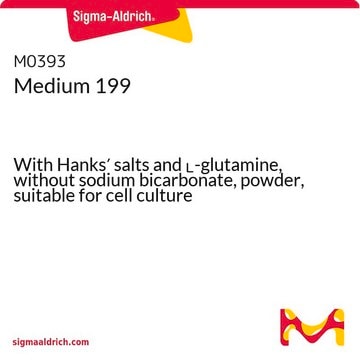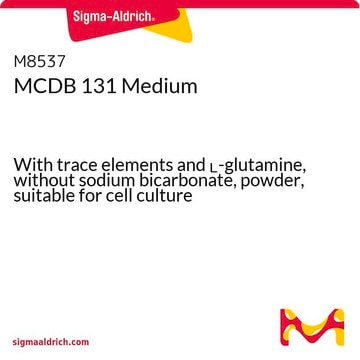M3769
Medium 199
Modified, with Earle′s salts, without L-glutamine, sodium bicarbonate, and phenol red, powder, suitable for cell culture
Synonim(y):
M199 Medium, TCM 199
About This Item
Polecane produkty
Poziom jakości
Postać
powder
metody
cell culture | mammalian: suitable
komponenty
L-glutamine: no
phenol red: no
HEPES: no
sodium pyruvate: no
Earle’s salts (5% CO2): yes
NaHCO3: no
Warunki transportu
ambient
temp. przechowywania
2-8°C
Szukasz podobnych produktów? Odwiedź Przewodnik dotyczący porównywania produktów
Opis ogólny
Zastosowanie
- to culture the primary human umbilical vein endothelial cells (HUVECs) for use in cell viability assay
- to flush the uterine horn of gilts to recover day 12 conceptuses from uteri
- to culture the peritoneal cells and immortalized human mesothelial cells (MeT-5A and ATCC-CRL-9444)
Ilość
Rekonstytucja
najczęściej kupowane z tym produktem
Kod klasy składowania
13 - Non Combustible Solids
Klasa zagrożenia wodnego (WGK)
WGK 1
Temperatura zapłonu (°F)
Not applicable
Temperatura zapłonu (°C)
Not applicable
Certyfikaty analizy (CoA)
Poszukaj Certyfikaty analizy (CoA), wpisując numer partii/serii produktów. Numery serii i partii można znaleźć na etykiecie produktu po słowach „seria” lub „partia”.
Masz już ten produkt?
Dokumenty związane z niedawno zakupionymi produktami zostały zamieszczone w Bibliotece dokumentów.
Klienci oglądali również te produkty
Produkty
Medium 199 supports non-transformed cell cultivation in virology and vaccine production, offering broad species applicability.
Nasz zespół naukowców ma doświadczenie we wszystkich obszarach badań, w tym w naukach przyrodniczych, materiałoznawstwie, syntezie chemicznej, chromatografii, analityce i wielu innych dziedzinach.
Skontaktuj się z zespołem ds. pomocy technicznej







